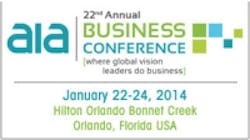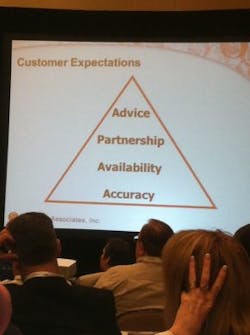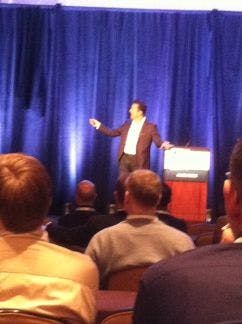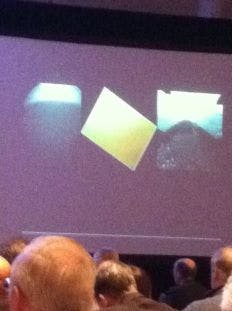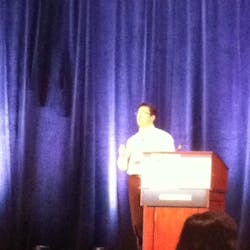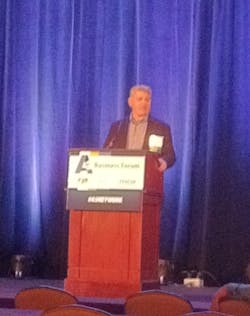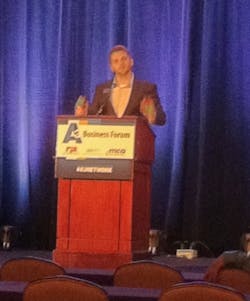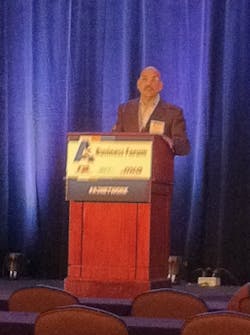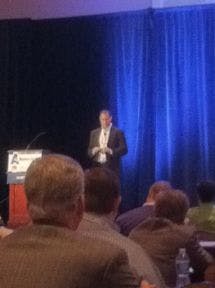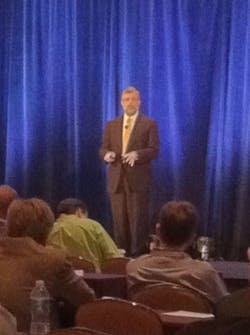Live updates from the AIA Business Conference
We will be providing live updates from the 22nd annual AIA Business Conference, which brings together key vision and imaging industry executives for talks, panel discussions, and networking. Keep an eye on this page as we update it throughout the conference with relevant quotes, predictions, and bits of news:
|
SPIE Photonics West 2014 preview: Cutting edge optics and photonics SPS IPC Drives 2013: All things automation |
January 23, 2014 8:45 AM ET
Creating a World Class Service Organization
Dennis Snow, President, Snow and Associates, who spent more than 20 years with the Walt Disney World Company, delivered a keynote address to the audience Wednesday night, offering advice on customer service and “creating a world class service organization.” Snow suggested a three-tiered approach to top-level customer service which applies across all industries:
- Look through the lens of the customer
- "Everything speaks" (Pay attention to the details)
- Create moments of "wow," however big or small
In addition, Snow suggests that it is paramount to keep customer expectations in mind:
January 23, 2014 9:34 AM ET
From Leading A High Performance Team to Landing on Mars
Adam Steltzner, Lead Landing Engineer for NASA’s Mars Science Laboratory Curiosity Rover Project provided an informative and entertaining history of NASA’s attempts to explore Mars, beginning with the Viking project in 1976 and culminating in the landing of the Curiosity rover in 2012.
Steltzner provided details of the Curiosity rover project and the emotions he felt throughout the process, but placed an emphasis on a number of key concepts. First, he suggested that "Great works and great folly may be indistinguishable at the outset." By this, he suggested that, although sometimes great ideas may initially seem unorthodox or even crazy, it doesn’t mean they aren’t great.
In addition, Steltzner was forthright in his declaration that the success of the Curiosity rover was only accomplished as a result of a great team. ("The quality of a product is a result of the quality of a team.")
Lastly, he left the crowd with the concept that “Design is exploration, exploration exists in finding new ways of doing things, and that invention makes a new universe for all of us.”
First images captured by the Curiosity rover:
January 23, 2014 2:20 PM ET
[Vision Technologies to Watch] Machine Vision with Depth: Time of Flight Imaging
Ritchie Logan, VP of Business Development with Odos Imaging Ltd. provided an overview of machine vision techniques and applications, before providing extensive detail on Time of Flight imaging and obtaining depth information, and how that process works. He also spoke about how the provision of depth information, when it comes to imaging, can help.
What does Time of Flight imaging and depth information add? Flexible and accurate data: Dual function pixels (Perfectly registered intensity and range), fast and easy capture of depth map (little or no post processing), simplicity to a system, and flexibility for integrators, according to Logan. He provided an example of examining a crate of beer bottles and how depth information enables a more complete inspection process.
Applications suitable for Time of Flight imaging include logistics, palletizing/depalletizing, agriculture, forestry/logging, and autonomous navigation, he suggests.
What’s next for Time of Flight imaging? Sensor resolution and the potential of color sensors (sensor development), longer ranges and outdoor capabilities (Illumination development) reduced cost and standard interfaces. (Market development.)
January 23, 2014 2:50 PM ET
[Vision Technologies to Watch] From Inspection to Intelligence
Jon Sobel, CEO, Sight Machine spoke to the AIA Breakout Session on the evolution of machine vision. He likened the progression of permanent music storing devices (albums, 8-tracks, albums, CDs) to today’s use of streaming devices (Pandora, Spotify), to the progression of machine vision in the sense that it followed a similar cycle:
Hardware innovation - software innovation - standards development - platform development
Sobel suggested that machine vision is on the beginning stages of the platform development stage. He spoke on how additional developments such as The Internet of Things and robots will further develop machine vision. In addition, he spoke about how machine vision does and will continue to allow us to solve whole new sets of problems; providing data down to the part level and enabling new applications such as comprehensive control of quality, solutions to warranty disputes between tiers, supply chain management, and logistics and traceability across industries.
Sobel also offered a number of suggestions:
- Know your available technologies
- Develop new applications
- Align incentives with those of the client
- Partner, collaborate, try new things
- Reframe—What is it we offer: Equipment or insight?
January 23, 2014 3:10 PM ET
Update on AIA Standards
Bob McCurrach, Director of Standards Development, AIA provided the audience with a general update on AIA machine vision standards. As of November 5, 2013, McCurrach showed that the most downloaded standards was GigE Vision, but also pointed out that global standards downloads are on the rise as a result of the collaboration between the AIA, JIIA, and EMVA.
Updates on standards/talking points included:
- Camera Link: Discussion points are Camera Link on FPGA and hardware tests for cameras.
- GigE Vision: Discussion points are 3D formats for GigE cameras and connector specification details.
- USB3 Vision: Current version already protocol and mechanically compatible with USB 3.1, compliancy process released, 9/10 companies to test USB3 Vision standard passed at the International standards meeting.
McCurrach also provided a calendar for the 2014 international standards meetings, including the Vision Show and the next PlugFest.
January 23, 2014 3:30 PM ET
Opportunities and Challenges for Vision in Pharmaceutical Applications
Jeff Najarian, Senior Engineer, Merck & Co, Inc. spoke about the use of machine vision in pharmaceutical applications, where cameras will need to meet certain specifications. Pharma manufacturing vision needs, he explained, include:
- Rate of 60-600 cpm
- 100,000 containers/day, 7/days a weeks
- Different containers and product types
- Defects down to 50 µm
- Environment: Grade A, C, or D clean rooms
He provided specific examples of what are some of the most critical aspects of vision-based pharmaceutical inspection, such as crack detection and particle detection. Najarian explained that vision component reliability is of the utmost importance, and that can sometimes display fractured images, so accuracy is of the utmost important.
Why would this be an issue? The problem is that, in order to make any change in such a heavily-regulated industry, it takes a significant amount of time. (Total time requirement for retuning a single camera can be one to four weeks, he says.)
Najarian also mentioned that, in order for cameras to be used in certain situations, such as event monitoring in a depyrogenation tunnel (200-400°) (a heating oven used to sterilize vials), cameras will need to be able to withstand harsh environments, including heat and corrosives. In addition, he spoke about the use of vision in pharma lab applications, where cameras can be used for:
- Container dimension measurements (Vials, syringes)
- Plaque/colony counting (Verify potency of virus product, verify sterility)
- Growth media sterility testing (Observe growth in containers)
He also mentioned that he envisions more cameras being used in clean rooms, as technologies advance. Areas for improvement, he suggested, include camera reliability, exact replication of components, crack detection in lyophilized products, glass particle/light plastic detection on lyophilized products, and contract resources for optimization.
January 23, 2014 4:17 PM ET
Presentation of annual AIA Achievement Award
The winner of the annual AIA Achievement Award is Michael Cyros, who has worked at Datacube, Euresys, and now at Allied Vision Technologies, as the CEO.
January 23, 2014 5:00 PM ET
Vision and Imaging Market Update for North America
Alex Shikany, Director, Market Analysis, AIA, informed the audience that 2013, despite the overall U.S. economy, had a very strong year when it comes to imaging and machine vision. This was largely due to a large increase in machine vision system sales. In addition—citing trends and forecasts—he suggested that 2014 will also be a strong year for the market.
Concerning manufacturing trends, Shikany indicated that the top three best-performing industries in 2013 were computer and electronic products, motor vehicles and parts, and aerospace and transportation. Putting the numbers together for 2013, factoring in final projections for 2013, Shikany shows an estimated 12% year-over-year growth from 2012. Also, the market for semiconductors saw a significant jump in 2013, which bodes well for the machine vision market moving forward.
Moving into 2014, the manufacturing sector is expected to add 252,000 jobs in 2014. The AIA predicts the strong performance from 2013 to continue through the first half of 2014, but expects a slowdown to occur in the second half of the year. In total, a 4.8% growth in 2014 is predicted.
Asian Vision and Imaging Market Update
Keith Reuben, President, Teledyne DALSA Asia-Pacific, offered a review of the machine vision market in Asia. From 2013 to 2014, Reuben indicated that an overall growth of 11% was predicted by Japanese marketing company Fuji-Keizai Co., Ltd. Reuben also provided general updates to the individual Asian markets:
Japan: A mature market with diverse applications, the Japanese machine vision shows a preference for local companies and a high standard for customer support. From 2013 to 2014, Fuji-Keizai Co., Ltd. predicts a 6% overall growth in machine vision, citing strong sales in vision systems, OEM system equipment, and machine vision cameras.
China: The largest manufacturer in the world, China has shown a double digit growth in the move to automation. The Chinese market is supported by its government’s economic policy as local companies begin to enter into the vision component market. High performance equipment however, is generally imported from the U.S., South Korea, Japan, and Taiwan, according to Reuben. The Chinese Machine Vision Union forecasts a 15-20% average annual growth into 2015, but the AIA predicts a lower rate of growth (but still predicts year-over-year growth.) Other countries, including Korea and southeast Asian countries, will begin to shift into China, according to Reuben.
SouthKorea: South Korea is an export-driven economy driven by a few large companies (called Chaebol, or conglomerates.) Many system OEMs are subsidiaries or spinoffs of these chaebols, and outside OEMs compete with the Chaebols in-house system groups. Semiconductors and electronics and flat-panel displays are dominant markets in South Korea, with new markets emerging in traffic, entertainment, medical, and more. Korea is expected to see a flat-to-decline in its overall machine vision market.
Opportunities exist in the Asian machine vision market due to it being the highest GDP growth region, a rising middle class driving consumer demand, and the move to automation to move up the value chain. Risks also exist, according to Reuben. These include the rise of new low cost competitors, China’s economic reforms, and so on.
January 24, 2014 8:55 AM ET
Opportunities for Automation in Contract Manufacturing
John Dulchinos, Vice President for Global Automation, Jabil Inc. discussed the state of global electronics manufacturing in today’s market. He displayed a chart showing that global electronics outsourced manufacturing have continuously and significantly grown from 1990 to 2014.
Stressing the idea that demographics and technology will make low wages irrelevant; Dulchinos explained automation has become a key initiative across the industry. Technologies like robotics and automation will add value to OEMs worldwide. So then, why aren’t there more robots installed? Cost, lack of reusability, short product life, low-cost of labor, and many factories are not ready to absorb complex automation, Dulchinos explained.
In terms of manufacturing, Dulchinos sees a global economy where Mexico supports North America and China supports Asia, due to lower costs. He also separated automation applications into levels which have increasingly larger costs and complexity:
Semi automation - Single process - Multiple process - Integrated sub assembly - Product assembly test and pack
January 24, 2014 9:55 AM ET
2014 Global Economic Forecast
For the last session of the day, Alan Beaulieu, Institute for Trend Research, provided a general overview of the 2014 global economic forecast. "The next four years are going to provide opportunities," he predicted early on in his presentation.
Beaulieu touched on the widespread perception that the American economy is still in recession, which he suggests is simply crazy. He backed this up by showing the audience a graph indicating steady economic growth from 2009 well into 2017. This is due to a number of circumstances:
- Stimulative monetary policy
- Employment rising
- Bank lending
- Retail sales rising
- Construction improving
- Deficit spending continuing
- Wages increasing
Following his look at the American economy, he provided an overview of the world economy. Among his other forecasts, he suggested that Europe will undergo a mild recession in the second half of 2014 going into 2015 and that Mexico will become increasingly important to the United States economy.
About the Author

James Carroll
Former VSD Editor James Carroll joined the team 2013. Carroll covered machine vision and imaging from numerous angles, including application stories, industry news, market updates, and new products. In addition to writing and editing articles, Carroll managed the Innovators Awards program and webcasts.
